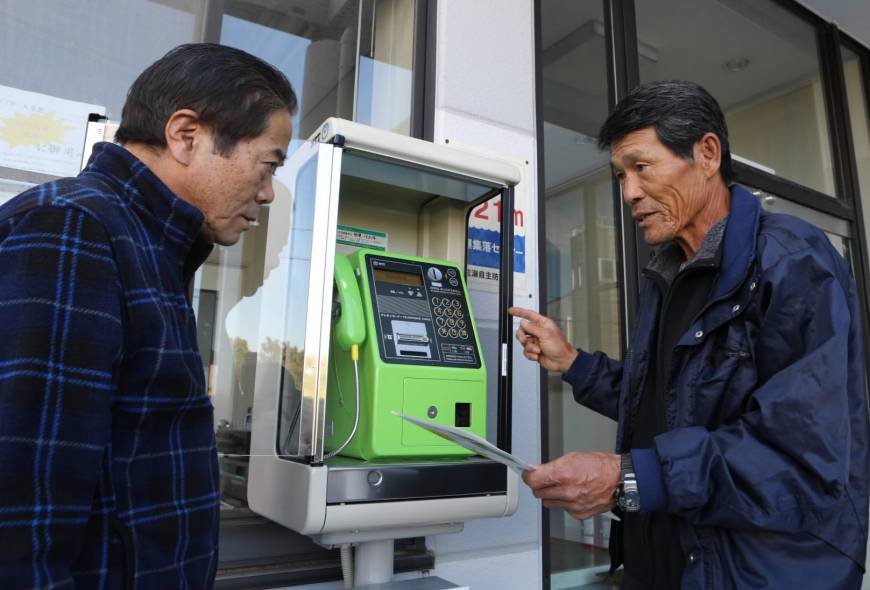 |
Hiroshi Suzuki (left) checks the procedure to collect coins from a pay phone set up at an emergency meeting point in
Tahara, Aichi Prefecture. | CHUNICHI SHIMBUN |
Residents in Tahara, which is located on the Atsumi Peninsula and vulnerable to tsunami, asked Nippon Telegraph and Telephone West Corp. to set up more pay phones in the area after seeing the rush of people using existing facilities in 2011.
Located on a narrow strip of land surrounded by ocean, it is estimated that if a large-scale earthquake were to hit the Nankai Trough, the city could be struck by tsunami up to 21 meters high.
The advantage of public pay phones is that their connections would not be restricted even when lines are crowded, in the same way as disaster priority phones.
In the event of a blackout, the switching center would continue to supply electricity to green pay phones, while gray pay phones will run on batteries.
Pay phones can also be used free of charge in large-scale disasters.
In the March 11, 2011 earthquake, communication facilities were destroyed by tsunami and the concentration of calls from the area caused disruptions to up to 90 percent of transmissions via fixed lines and mobile phones.
As a result, people who wanted to confirm the safety of their loved ones or make an emergency call rushed to public pay phones.
In Iwate, Miyagi and Fukushima prefectures, the number of phone calls made from public phones on March 11 increased sixfold from the previous day to 300,000, while some 4 million calls were made in the Tokyo metropolitan area on that day, 15 times more than the previous day.
The decision to increase the number of pay phones in Tahara was made after a meeting held by the Tahara disaster management council in June, where NTT West and Tahara police explained the advantages of pay phones to the residents.
They agreed that pay phones would provide them with the means to ask for help or inform others of their situation in the event of a natural disaster.
Twelve new phone booths are set to be installed by March, of which nine will be at community meeting facilities, two in civic halls and one at an elementary school. Three are already in use.
Most of these locations are designated shelters or on evacuation routes, but some will also be placed in areas on the Mikawa Bay side of the peninsula that are projected to be affected by tsunami.
Even if these booths were hit by tsunami and knocked out, they could still be used to identify disaster-affected areas.
The booths will be installed outdoors and accessible 24 hours.
NTT West will bear the cost of setting up and maintaining the booths, while local resident associations will make monthly rounds to collect the money inside the phones.
The total number of phone booths in Tahara will reach 74, up 20 percent.
Tahara previously distributed wireless transceivers to 106 local resident association leaders as a way to maintain communication with the city’s emergency headquarters and shelters. But the line is often busy and it is hard to get a connection sometimes.
“To have more choices of communication can help alleviate citizens’ concerns. Collecting coins once a month is not a burden when you consider that they can save lives,” said Hiroshi Suzuki, 66, head of the city’s federation of regional community associations.
“Public pay phones can function as a lifeline connecting residents with police. I hope that other cities will consider following suit,” said Atsushi Hoshino, head of the Emergency Response Division at the Aichi Prefecture Disaster Prevention Office.
“The most important thing in times of disasters is to ensure communication. It’s good that citizens have realized the benefit of having pay phones, which has led to more being installed. Hopefully it can also lead to more discussions on society’s infrastructure,” said Nobuo Fukuwa from the Nagoya University Disaster Mitigation Research Center.
“Nevertheless, installing more pay phones alone is not a solution. As it becomes harder to maintain the upkeep of these phones, we need to think about how we can maintain (means of communications) . . . in this society as a whole,” he added.
According to the government’s 2015 information and communications white paper, there were 183,655 pay phones in Japan as of the end of March 2015, less than half compared with the end of March 2006.
To ensure public safety and provide minimum access to communication while outdoors, the Telecommunications Business Law regulations state that there should be one public pay phone installed every 500 sq. meters in urban areas and one every 1 sq. kilometer in rural areas.